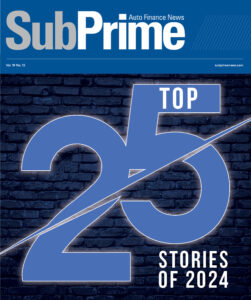S&P Global Ratings sees history repeating itself within subprime ABS

Share a conversation with an executive who has been in subprime auto finance for a decade or two and likely the professional will say, “Yes, I’ve seen that before,” at some point during the exchange.
The latest research of managed portfolio performance by S&P Global Ratings reinforced the probability that conversation might be happening now.
Analysts noticed a historical pattern of rapid growth followed by performance deterioration when they explored the current managed portfolio performance of subprime auto finance companies that have rated subprime auto finance asset-backed securities (ABS).
S&P Global Ratings on Monday offered a copy of the resulting report titled, Looking Back, Looking Forward: Lessons On U.S. Subprime Auto Loan ABS Performance.
In 2019 through 2022, S&P Global Ratings determined, subprime managed portfolios’ total aggregate outstanding amount grew at an annual compound rate of 10%. Analysts noticed losses and delinquencies started rising in 2022 after both declined in 2020 — with losses declining further in 2021 due to COVID-19-related stimulus and higher used vehicle values and recovery rates.
However, by the end of last year, 31-plus-day delinquencies had reached a record high, and losses had climbed to an eight-year high as inflation impacted affordability and recovery values normalized, according to the S&P Global Ratings tracking shared with Cherokee Media Group.
Analysts reported that average 31-plus-day delinquencies jumped to a record rate of 13.65% by the end of 2023. Meanwhile, S&P Global Ratings watched net losses soar 32.00% to 8.93%, similar to the 2016 reading of 8.81%.
“In response to the weaker performance, lenders generally tightened their underwriting standards, resulting in slower aggregate managed portfolio growth,” S&P Global Ratings said.
Analysts pointed out a similar development occurred from 2012 through 2015 when the subprime managed portfolios’ total aggregate outstanding amount increase at a 24% annual compound rate.
And S&P Global Ratings said that after three years of rapid expansion in this highly competitive market, delinquencies and losses peaked in 2016 despite declining unemployment rates.
“Several lenders (including some large banks that didn’t traditionally securitized these riskier loans) responded by scaling back their origination volumes as their focus moved to quality rather than quantity,” analysts said. “Portfolio growth slowed in 2016 and 2017 as a result (with only 4% growth in each year), which led to a reduction in late payments in 2017 and 2018 and losses in 2017 through 2019.”
To reinforce those assertions, S&P Global Ratings recapped that the outstanding portfolios held by Santander Consumer USA and Exeter Finance declined 5% and 3%, respectively, in 2016. Furthermore, analysts said Santander’s portfolio size dipped by an additional 5% in 2017.
“These declines led to lower losses for Exeter in 2017 and 2018 and for Santander in 2018 and 2019,” analysts said.
In 2023, total aggregate outstanding subprime auto loan ABS receivables rose 5% to $87.1 billion, according to S&P Global Ratings.
What do the data and trends mean? Remember the possible anecdote established executives might be saying now.
“If history repeats itself, this slower portfolio growth, which was due to lenders’ increased focus on quality, should be followed by lower delinquencies and losses for the remainder of this year, assuming the U.S. economy remains healthy,” S&P Global Ratings said in the report.
“Historically, when lenders tighten their credit standards, which we believe they have, beginning in mid-2022, their performance metrics improve in the following years,” analysts went on to say.

 View The Latest Edition
View The Latest Edition

